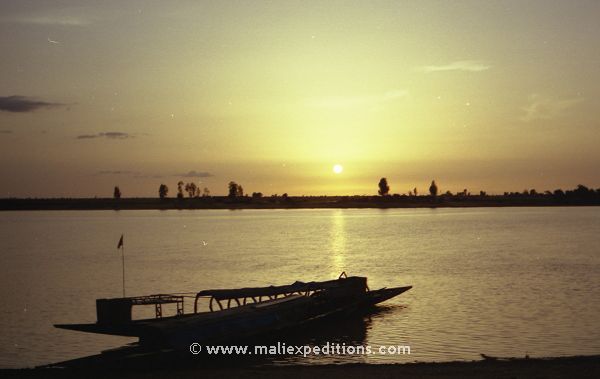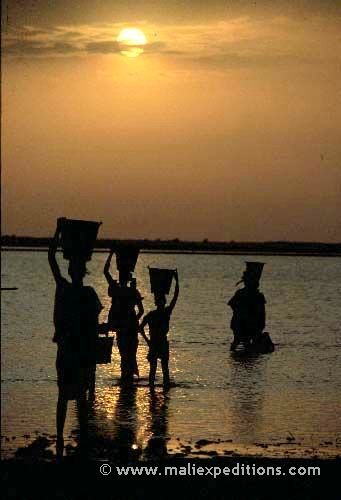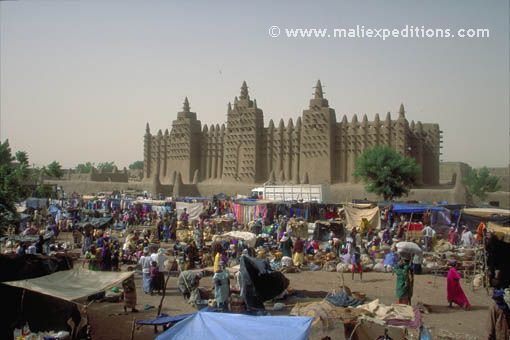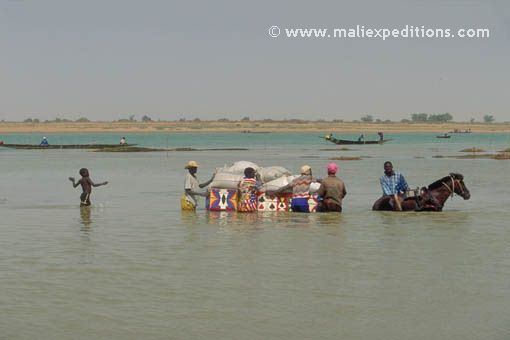|






BPE 2018 Bamako
MALI
Tel. +223 20217140
Fax: +223 20217140


| |
Interesting Places - Page 1
-
THE NIGER, THE RIVER OF RIVERS OR THE BIG VEIN
The Niger, a world in its own, provides Mali with a connecting link
between the savannah and the desert and a valuable means of
communication. The strange realm of river waters has its gods-such as
those of the Bozo fishermen who are still much attached to animist rites
– and its subjects-the same Bozos, whose entire livelihood comes from
the river itself, and the somonos, specialists in handling dugout
canoes. However, all Mali’s inhabitants do to some extent depend on the
River King who has its own territory and provinces – the vast inner
delta.

Over an area of 30,000 sq kms, the water hesitates, wanders,
breaks up into bachwaters and runs together again, thus forming the
unique landscape where it is difficult to say where the land ends and
the water begins. During and immediately after the rainy season, from
July to December, the entire plain is flooded, allowing the navigation
of ships of considerable tonnage.
The Niger is also the realm of commerce From the ancient times of the
Empire of Ghana until now, traffic on the river has hardly ever stopped.
The opportunities provided by this watercourse have always been
paramount : a 1,500 km long open road, accessible in all weathers and
times, naturally linking north and south, the heart of Black Africa and
the extreme limits of North Africa. Today the Niger is the main artery
of the state economy continuing to fulfil its ancestral role of providing
a means of communication.
Navigation on the Niger allows the best possible contact with the
country as it is : the shores, which slip pas within hailing distance,
provide numerous scenes of day-to-day life. You see the Mali of days
gone-by: rush-built villages, fortified towns nestling around their
mud-built mosques, dugout canoes, traders, nomadic shepherds, markets,…
To sail down the river is to select the most authentic way of
assimilating with the country in its many cultural, economic and human
aspects. To practice the art of unhurried contemplation, living at the
slow speed of the waters and “wasting” a few hours to discover the
secret of a century-old wisdom.
-
BAMAKO
Founded in 1640, the city gests its name from the two Bambara words
“Bama” and “Ko”, meaning respectively crocodile and river. Located at
the centre of the old Mandingo country on the banks of the Niger, and
with more than a million inhabitants, Bamako is very pleasant and
hospitable city.

The city presents quite a few old colonial style
buildings (1900-1914), an interesting National Museum, a lively market,
the Craftsmen’s souk, the Cathedral and many good restaurants (local and
international cuisine).
-
SEGOU
Former capital of the Bambara Kingdom founded in 1852 by Kaladian
Coulibaly, Segou is today the capital of the 4th economic region of Mali
and one of the main industrial and commercial centre of the country.
220km north-east of Bamako and stretching for 8km along the Niger, Segou
is also an important agricultural centre for “Karite” nuts and mango
fruit. According to tradition, the Segou region hosts the mysterious
“4444 + 1 balanzans (acacia albida)” : of these trees – strangely leafy
during the dry season – 4444 have been counted but the location of the
last one remains unknown.
-
DJENNE
Tombouctou would not have known the splendour it did HAD IT NOT BEEN FOR
ITS TWIN CITY TO THE SOUTH Djenne. And Djenne would have remained an
undistinguished town, if Tombouctou had not existed.

In the history of
Mali the towns have maintained exemplary commercial, intellectual and
religious links. For long their history was one, and the decline of one
soon had repercussions on the other. However, Djenne is not a mere
duplicate of Tombouctou, in fact it has acquired a character of its own.
Located in the heart of the inner delta of the Niger, Djenne is a real
island emerging from the high waters during the raining floods.
Protected by water for several months of the year, and the rest of the
time safely guarded by its walls, the town has remained practically
untouched by pillage, fire and other catastrophes (from which Tombouctou
did not escape). Today Djenne looks almost exactly the same as when the
French traveller Rene Caille first saw it in 1828, and what he saw had
scarcely changed since the Middle Ages. He noted the town’s power and
beauty: Djenne was proud of its mosque (and of the religious and
intellectual influence it implied), its trade and its architecture (and
of the wealth and taste of its inhabitants).

Djenne, on the banks of a tributary river of the Niger called the Bani,
was founded at the beginning of the IX century. It was named “Little
however, it started to develop only in the XII century, when Timbuktu
started to flower. The town was converted to Islam, acquired a mosque
and merchants from the south flocked here with their loads of gold,
ivory, cola nuts and wool heaby canoes were built to carry tens of tons
of these products to Tombouctou, which traded with the north. Thus in
the Middle Ages there emerged a refined urban civilization of which Es-Sadi
author o the Tarikh-es-soudan and native of Timbuktou-wrote “This town
is large, flourishing and prosperous; it is rich and blessed and
favoured by Heaven”.
The decline of Djenne in the XIX century was not unconnected with the
attempt to restore Islamic fundamentalism led by Cheikhou Amadou. This
political and religious leader literally chased the merchants out of the
temple, transferred the markets of Djenne further east (it was he who
crated Mopti) and demolished the centuries old mosque to build one more
to his taste.
 Today’s mosque was built in 1907 on the foundations of the
old one and has by now acquired a well deserved fame. Mud-cloth to the colourful market, the great Mud mosque is itself very impressive with
its earthen walls smoothed by hand, a real miracle of Sudanese-Sahelian
architecture. Today’s mosque was built in 1907 on the foundations of the
old one and has by now acquired a well deserved fame. Mud-cloth to the colourful market, the great Mud mosque is itself very impressive with
its earthen walls smoothed by hand, a real miracle of Sudanese-Sahelian
architecture.
The town at present delights the eye with the splendid architecture of
its houses and buildings, and is a rare example in West Africa of an
area completely preserved from ravages of time and outrages of
modernity. UNESCO lists old Djenne as a World heritage site. The most
impressive day to arrive is Monday, market day. As noon approaches the
bright light brings the colours of the native garments to life and the
noise of the crowd fills the space in front of the mosque. Especially
stiking is the extraordinary variety of narrow passages between the
stalls. Among them are Dioulas, merchants from the south; Bambara
farmers selling their rice, millet and cotton; the little Dogon women
standing solemnly behind their piles of onions. But since the XIX
century Djenne is mostly a Peulh town. Every Peulh is a nobleman, but
they cares for nothing except what for him represents real wealth,
livestock. Peulh women are identifiable from far: they sell butter and
fresh or curdled milk, all contained in three or four calabashes
gracefully carried on their head. But above all, they wear an elegant
hairs-style and unique jewellery.
In the heart of old Mali, the renown of Djenne will for many years to
come draw admiring visitors, as it has done for the past thousands of
years.
  
|
